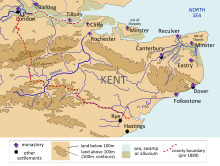Fordcroft Anglo-Saxon cemetery
Archaeologists affiliated with the local Orpington Museum began excavating in 1965, expecting to find evidence of Romano-British occupation, but after discovering the cemetery decided to focus on it.
[2] Several Victorian cottages had been built atop the cemetery, but were demolished during the following century, when the site became "overgrown with weeds and littered with rubbish" prior to excavation.
[2] With the advent of the Anglo-Saxon period in the fifth century CE, the area that became Kent underwent a radical transformation on a political, social, and physical level.
[4] Later Anglo-Saxon accounts attribute this change to the widescale invasion of Germanic language tribes from northern Europe, namely the Angles, Saxons, and Jutes.
[11] The earliest excavation of Anglo-Saxon Kentish graves was in the 17th century, when antiquarians took an increasing interest in the material remains of the period.
[16] Many of the skeletons were heavily decayed, although in many cases the teeth and long bones were sufficiently preserved for osteoarchaeologists to determine the age and sex of the individual.
[17] Due to 19th century construction on the site, it was impossible for the archaeologists to accurately determine where the Anglo-Saxon ground level had been, and therefore how deep the graves had been cut.
[13] In the 1940s, a service trench had been excavated in the adjacent Bellefield Road by workmen, who revealed pieces of Romano-British pottery.
Archaeologist A. Eldridge published this discovery in the Archaeologia Cantiana journal, suggesting that there might have been a building dating to Roman Britain nearby.
[18] Elderly members of the community who had formerly lived in the cottages on the site visited the excavation, providing "likely and amusing comments" following the revelation that they had dwelt above a cemetery.
[19] The team excavated all available areas, although were unable to dig under either of the roads enclosing the site, or under the houses to the east and west.
